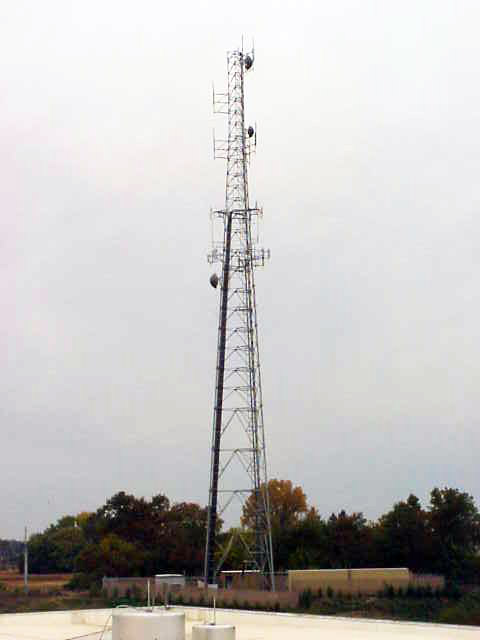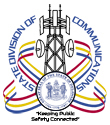Digital 800 MHz Statewide Trunked Radio System

On October 15, 1993 the State of Delaware purchased a Statewide 800 MHz Digital Trunked Radio System to provide statewide communications for all state, county and municipal government agencies, fire and emergency medical services, and a select number of federal agencies. The system was designed to provide 95% in-street coverage using a portable radio. The State contracted with Motorola, Inc. for a digital system, which was compatible with the Association of Public Safety Communications Officials-International, Inc. - Project 25 (APCO 25) standards as of that date, such as the "common-air-interface" standard. Construction of the 18 original tower sites for the system infrastructure started in March 1996.
The system is sub-divided into three geographic regions, which corresponds to the three counties in the State, with fourteen channels in our New Castle County, and ten channels each in our Kent and Sussex Counties. The system design incorporates a digital microwave (6 & 10 GHz) infrastructure, which links the three sub-systems and the intra-county system sites together. To enhance operational capabilities the City of Wilmington's 800 MHz system was also modified to provide limited interoperability between the State's system and the City's system. There are three primary dispatch control points, one at each of the three 911 dispatch centers. The 911 dispatch center in Kent is connected to the system via fiber optics, versus microwave. The dispatch control consoles provide voice logging and instant playback recording and they interface with conventional radio systems in other frequency bands. In addition to these primary control points there are many other secondary console and radio frequency (RF) control stations located within other facilities such as, fire stations, police stations, and highway yards, etc.
In July 1998 the State accepted the New Castle County portion of the system. In September 1998 the Sussex portion was accepted and in October 1998 the Kent portion was accepted. Although all three phases of the project had been accepted the State's final acceptance was withheld pending resolution of in-street coverage issues.
To resolve those issues, Motorola recommended and agreed at no cost to the State, to upgrade portables and mobiles with newer software, lower power on mobiles to reduce the possibility of receiver desensitivity, and add four "Intellirepeater" (IR) sites containing the minimum equipment required to enhance coverage in the specific areas that did meet user expectations. These sites were connected to the system by phone lines instead of microwave. Due to a lack of available frequencies they also agreed to add one site in New Castle County using a bi-directional amplifier (BDA) connected to the system by fiber optics. The warranty period was placed on hold pending completion of these enhancements. Later, the State installed another BDA in New Castle County to further improve coverage. On June 6, 2001 the State granted final 800 MHz system acceptance and signed the Certificate of Acceptance.
Although the IR sites and BDA's improved coverage they created other operational issues. In July 2000 the State appropriated funds to resolve those issues and improve in-street coverage in the Rehoboth, Claymont and Hartly areas. The IR site in Rehoboth was converted to a full simulcast site and connected to the rest of the system by microwave. Another simulcast site was added in the Claymont area. The IR site in Hartly was connected to the rest of the system via microwave and another channel was added to reduce the potential for system busies. In addition, an existing site in NCC was expanded to provide additional coverage in Kent County. These enhancements were operational by July 26, 2002. Final acceptance occurred on September 27, 2002.
Next, communications interoperability with surrounding State's was enhanced. Our communications between States, through mutual aid channels, has always been possible; however, programming radios to work on each State's system improved our joint operations significantly.
On October 1, 2004 the State contracted with Motorola, Inc. to enhance the system again. These enhancements consisted of five initiatives. The first was to enhance the State's current level of in-building coverage to provide in-building coverage throughout the State by construction of additional tower sites, use of bi-directional amplifiers, and federally funded vehicular repeater systems. The second was to upgrade all of the dispatch consoles in the State, expand the number of consoles from 54 to 123, while standardizing and improving redundancy within and between all 911 Centers. Third, was to upgrade the master control system platform to extend the system's lifecycle. Fourth, was to upgrade regional intra/inter-operability. This was accomplished though a federal grant which replaces the City of Wilmington's 800 MHz analog radio system with an 800 MHz digital IntelliRepeater system which is fully integrated into the State's system. Additional equipment was installed inside the three primary 911 Centers which allow patching of Delaware's system with talkgroups or channels from the surrounding jurisdictions that have systems which are not compatible with Delaware's system. The State also expanded its mutual aid infrastructure to enhance coverage and to serve as a back-up system in the event of a catastrophic failure of the prime system. The fifth initiative replaced the existing microwave infrastructure with a higher capacity network and more redundant links to support the radio system plus other current and future needs. All of the initiatives were completed by October 2008.
In 2014 DivComm in partnership with Motorola installed a new Master Site Zone Controller at our prime site in Smyrna. This was necessary as the current Master Site Zone Controller was past end of life.
The system's capabilities expand continuously... the number of users on the system grows... the future brings more.







